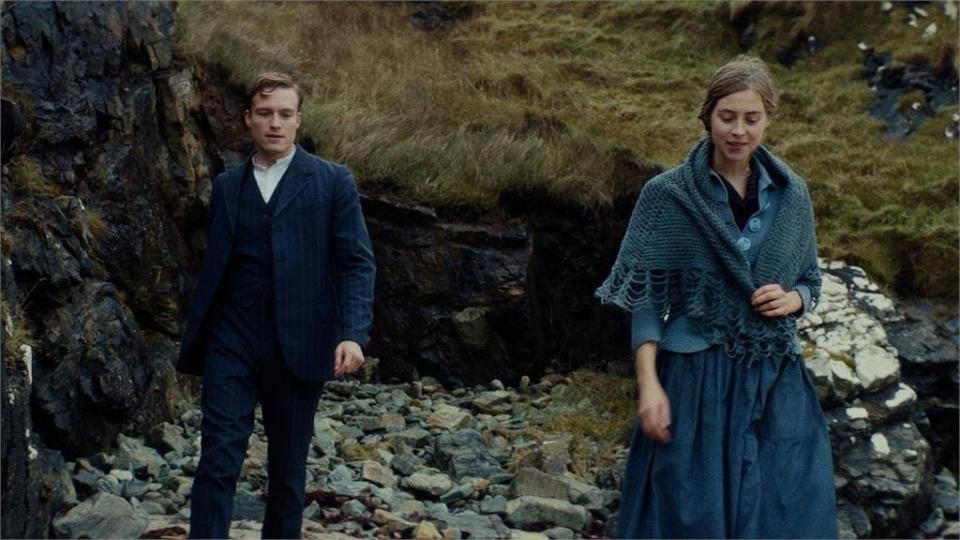Scottish 'weepie' centers around women's wartime resilience | Movie review
- Oops!Something went wrong.Please try again later.
The Scottish Hebrides and the sea surrounding them become almost a character in Richie Adams’s “The Road Dance” — at once verdant and welcoming, churning and bottomless.
Adapted from John MacKay’s 2002 best seller of the same name, “The Road Dance” follows Kirsty Macleod (Hermione Corfield), a beautiful and self-possessed young villager as she falls in love with Murdo (Will Fletcher), a young man mocked for his head-in-the-clouds affect and affinity for Robert Frost.

Early in the film, the couple’s dreams of migrating to America are interrupted by the outbreak of World War I and Murdo’s subsequent conscription. The film then moves into a darker register when, following the titular road dance celebrating the men’s departure for the front, Kirsty is raped by a man she cannot identify.
The remainder of the film, baring a few final plot twists, adheres to familiar period “weepie” beats. Kirsty attempts to hide her pregnancy and post-trauma anxiety while mourning Murdo’s absence; the villagers rally to support the war effort.
Overall, the film evidences both narrative and tonal confusion. For while “The Road Dance” initially hints at a Hallmark-style romance embedded in an immigration story, the remaining narrative largely seeks to parse the personal, familial, and communal fallout of Kirsty’s experience of sexual violence.
The film’s initial saccharine register and later realist treatment of trauma (including a graphic birth scene) create a somewhat dissonant experience for viewers.
At its most skillful, “The Road Dance” makes women’s lived experiences of everyday violence tangible, allowing viewers to dwell in moments of painful embodiment which foreground the body’s materiality and its vulnerability. The labor scene and its aftermath are particularly evocative, momentarily retexturing the film’s sensibility and affective possibilities.
Contrasting the film’s visceral treatment of birth, the violence the village men experience on the battlefield is rendered an abstraction — viewers are offered only one glimpse of the combat, which, shot in slow motion and muted to accommodate a voice-over, spares us much of trench warfare’s gore.
The scene has a sanitized quality; its closing shot, which hovers at a distance above Murdo’s prone body, renders him somewhat plastic — more the idea of a fallen soldier than a bruised and battered man.
The visibility of death on the front allows the film to attempt critical comment on the unspeakable quality of the violence Kirsty experiences at home. When, regarding the cause of Kirsty’s pregnancy, her mother asks, “do you think they’ll care?” she highlights both the precarity of women’s lives in this context and the mandate of secrecy that makes such precarity unreadable.
Formally, the film echoes the women’s affective experience through dim and claustrophobic interior scenes which contrast sweeping aerial shots of the Hebridean countryside. Carlos José Alvarez’s score, which prominently features high-pitched strings, heightens this effect.
Indeed, around the climax of the film, the small-town setting of “The Road Dance” begins to take on panopticon-like characteristics—the doctor, constable, and minister register as cartoonish embodiments of power and control.
When the minister warns against the desires of the flesh and the constable demands a purity test (to which the doctor unquestioningly complies), Kirsty appears caught within transparently Foucauldian systems. And yet, when the constable is later reframed as a well-intentioned truth-seeker and the doctor is given the “one bad apple” treatment, the film loses its tenuous grasp on structural critique.
While “The Road Dance” asks viewers to “pity those who remain” outside the war’s grasp, one can’t help noting that the violence Kirsty experiences is only incidental to the conflict.
Thus, while the film seeks to parallel the violence (rape, birth) women experience at home to that encountered on the front, it simultaneously implies, seemingly without intending to, that Kirsty’s experience — rendered spectacular in the film — is actually rather ordinary.
Emma Bruce is an MA student in the Literature, Media, and Culture program at FSU. Their essays can be found in Hippocampus and elsewhere.
If you go
What: “The Road Dance” presented by the Tallahassee Film Society
When: 7 p.m. on Friday, Dec. 8; 5 p.m. on Saturday, Dec. 9; 5 p.m. on Sunday, Dec. 10
Where: All Saints Cinema, 918-½ Railroad Ave.
Cost: $11 general admission, $9 for TFS members and students; visit tallahasseefilms.com
This article originally appeared on Tallahassee Democrat: Women's wartime experiences examined in Scottish 'Road Dance'

